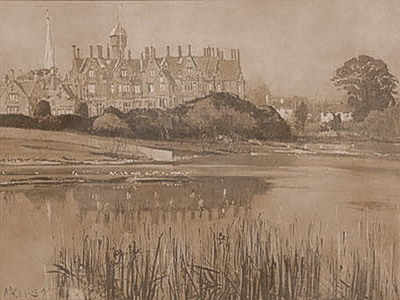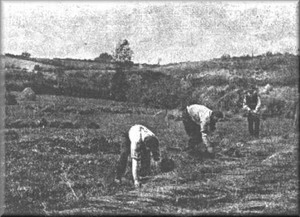A Brief History of Lurgan




Earlier names of Lurgan include Lorgain Chlann Bhreasail (long ridge of Clanbrassil), and Lorgain Bhaile Mhic Cana (long ridge of McCann's townland) which was anglicised to Lurgivallivacket. The McCanns were a cept of the O'Neills and Lords of Clanbrassil prior to the Plantation of Ulster period in the early 17th century.
 The excitement and consternation created by the flight of the Earls of Ulster in the autumn of 1607 had barely subsided when the project for the plantation of Ulster by British settlers was put into being. By that scheme the northern counties became peopled with
inhabitants of English, Welsh and Scottish extraction.
In around 1610, during the Plantation period and at a time when the area was sparsely populated by Gaelic peoples, the lands of Lurgan were given to the English lord William Brownlow and his family. Under that scheme John and William Brownlow obtained grants in Oneilland Barony securing 1,500 and
1,000 acres respectively. Carew in his report of 1611 said the Brownlows had brought over 6 carpenters, one mason, one tailor, and six workmen and had placed one freeholder and six tenants upon their lands.
Initially the Brownlow family settled near the lough at Annaloist, but by 1619, on a nearby ridge, where they had established a castle and bawn for their own accommodation." The excitement and consternation created by the flight of the Earls of Ulster in the autumn of 1607 had barely subsided when the project for the plantation of Ulster by British settlers was put into being. By that scheme the northern counties became peopled with
inhabitants of English, Welsh and Scottish extraction.
In around 1610, during the Plantation period and at a time when the area was sparsely populated by Gaelic peoples, the lands of Lurgan were given to the English lord William Brownlow and his family. Under that scheme John and William Brownlow obtained grants in Oneilland Barony securing 1,500 and
1,000 acres respectively. Carew in his report of 1611 said the Brownlows had brought over 6 carpenters, one mason, one tailor, and six workmen and had placed one freeholder and six tenants upon their lands.
Initially the Brownlow family settled near the lough at Annaloist, but by 1619, on a nearby ridge, where they had established a castle and bawn for their own accommodation."
By 1619 however, John Brownlow was dead and William was in possession of the two manors. The 1619 Pynnar's survey of the town tells us that there was a very fair town consisting of 42 houses all inhabited by English families with streets paved clean through. By then there were 5 freeholders and 52 tenants holding leases for years, in all 57 families....all of whom had taken the oath of supremacy and were able to muster 100 men in with arms. There was also two water-mills and a windmill, all for corn, and a store of arms in the manor. There was then a good store of tillage on the property but not one Irish family upon all the land. William Brownlow must, however shortly afterwards have given way to the temptation of high rents and ready payments offered by the natives. An inquisition of
1630 shows that in that year he was brought to book by the Government in consequence of such lettings.
In 1629 he had a re-grant of the two manors by which they became united as the Manor of Brownslow's Derry.
At the same time a patent was issued for a market every Friday at Ballylurgan and two fairs on the
Feast of St James and Feast of St Martin. This shows that by then the town had become a place of
importance in the social life of the area and gives Lurgan's markets and fairs an ancestory of over three
hundred and fifty years.
Brownlow became MP for Armagh in the Irish Parliament in 1639. During the Irish Rebellion of 1641, Brownlow's castle and bawn were destroyed, and he and his wife and family were taken prisoner and brought to Armagh and then to Dungannon in County Tyrone. The land was then passed to the McCanns and the O'Hanlons. In 1642, Brownlow and his family were released by the forces of Lord Conway, and as the rebellion ended they returned to their estate in Lurgan. The British settlers were again in full occupation by 1654, in which year William Edmundson disturbed a service in the parish and was beaten for his pains. In 1657, Cromwell caused an inquisition to be made of
the county parishes from which we gather that the town had returned to normal conditions. At any rate the
church was in good repair and a school functioning.
William Brownlow died in 1660, but the family went on to contribute to the development of the linen industry which peaked in the town in the late 17th century.
In 1684 the first Presbyterian congregation in the town is said to have been formed, and some years later in
1696 a Quaker meeting house was built. There were troubled times during the Williamite wars of 1688-1691, the outcome of which was to influence European politics. Many of the Protestant Huguenot families were arriving in Ulster at this time from religious persecution in France. Evidence of the religious acceptance of the Brownlows is the fact that Arthur held the unique distinction of being the only member of Parliament to sit in both the Parliament of King James II and the Williamite Parliament. Despite the difficult times the town continued to grow for the population in 1693 was reckoned at 500. In the closing years of the century Lurgan began to develop as a Linen centre. We have a pen picture of the town as it was then in Dr Thomas Molyneaux's journey to ye North, written in 1708...he passed through a mighty pretty English like enclosed country well planted with large trees to Mr BROWNLOW's town of Lurgan, which he describes as "at present the greatest mart of linen manufactories in the North, being
almost entirely populated with linen weavers and all by the care and cost of Mr BROWNLOW.."
 By the early eighteenth century the town was beginning to acquire the shape it still displays, built along
the long ridge of land bounded on both sides by small streams.
In 1712 James QUIN of Carlow was induced by William BROWNLOW to take up his abode in Lurgan and
begin the manufacture of damask and by 1714 fine cambric was being produced in the district. At this time
the making of linen was essentially a domestic affair. The flax was scutched at home. Daughters and
servants spun the yard: the sons wove the linen and the bleaching was effected by the same hands. Later,
following the invention of the fly shuttle, the KELLY family were among the most celebrated shuttle
makes in the North.
Among the famous local linen families were the BRADSHAWS. James BRADSHAW, a linen
manufacturer, obtained trade secrets when visiting Holland in 1717 and in doing so barely escaped with his
life, for such secrets were valuable.
By the mid-eighteenth century the town was flourishing, largely due to the manufacture of linen. The weekly
linen market attracted many visitors to the town wishing to avail themselves to the high quality woven fabric.
At this point in time the town had a population of around 4,500.
In an account of Lurgan written in 1751 by the Rev. Richard BARTON, there is a vivid representation of
the Lurgan linen market. Linens were then sold in the open markets - the Linen Hall does not seem to have
been built until later. They were measured under cover in the public-houses and custom had made it a rule
that the sellers of webs should expend at least three pence in liquor for the good of the house. At the same
time there was a soap manufacturer in the town. Five years late, in 1756, John Wesley arrived in Lurgan in
the month of July and preached in the Market House. He continued to pay regular visits to Lurgan for over
twenty years.
From contemporary newspapers we learn that in 1781 there were at least two social clubs meeting in
Lurgan, the Lurgan Club in the Black Bull Inn, and the Men of O'Neiland in the Blackamoor Inn. Cock-
fighting was one of the local pastimes at that time and was patronized by all classes.
The town grew steadily over the centuries as an industrial market town, and in the 1960s, when the UK government was developing a programme of new towns in Great Britain to deal with population growth, the Northern Ireland government also planned a new town to deal with the projected growth of Belfast and to prevent an undue concentration of population in the city. Craigavon was designated as a new town in 1965, intended to be a linear city incorporating the neighbouring towns of Lurgan and Portadown. The plan largely failed, and today, 'Craigavon' locally refers to the rump of the residential area between the two towns. The Craigavon development, however, did affect Lurgan in a number of ways. The sort of dedicated bicycle and pedestrian paths that were built in Craigavon were also incorporated into newer housing areas in Lurgan, additional land in and around the town was zoned for industrial development, neighbouring rural settlements such as Aghacommon and Aghagallon were developed as housing areas, and there was an increase in the town's population, although not on the scale that had been forecast.
The textile industry remained a main employer in the town until the late twentieth century, with the advent of access to cheaper labour in the developing world leading to a decline in the manufacture of clothing in Lurgan



|

